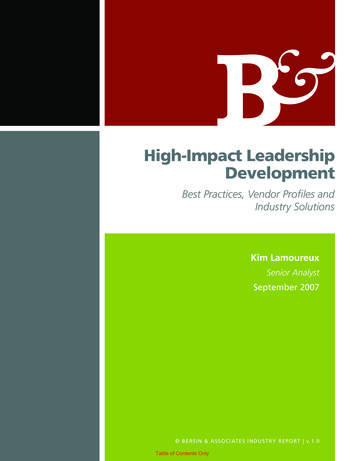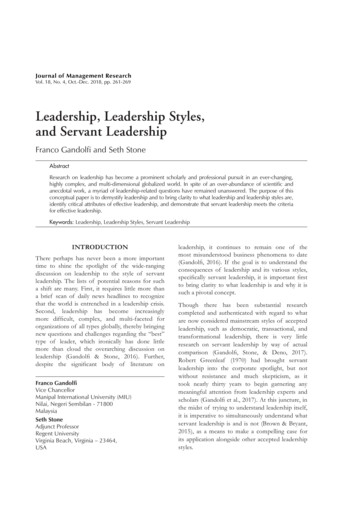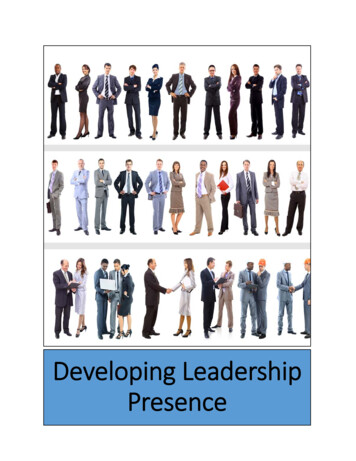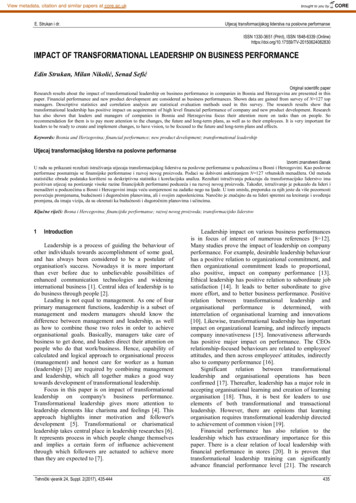
Transcription
LEADERSHIPDEVELOPMENTTOOLS
‘SELF-EXPLORATION INAN ORGANISATIONAL CONTEXTCAN HELP EXECUTIVESWITH ONE OF THE MOREDIFFICULT LEADERSHIP TASKSTHEY MAY EVER FACE:CHANGING THEMSELVES.’Manfred Kets De VriesKDVI offers a suite of innovative psychometrically validated 360 feedback instruments targeting global business executives. Ourinstruments intervene at three levels:› Individual: To provide insights for a constructive dialogue aboutthe way a leader functions and implicit and explicit behaviours thatneed further development.› Team: To provide structure for team development initiatives byoutlining the qualities, skills and competencies that leaders musthave to be effective in teams, the roles they play and the wayvarious roles complement or work against each other.› Organisational: To provide guidance for strategic discussions thatcentre around corporate culture and to align values and behavioursto business strategy.Used together, these instruments provide a systematic approach toassessing leadership and organisational effectiveness.360 leadership development tools can be the beginning of anintrospective journey and set into motion honest self-evaluation andchanges in behaviour. Feedback from different stakeholders providea useful way for leaders to compare their self-perceptions with theobservations of colleagues or others who know them well. They helpexecutives make connections between patterns of conflict at workand interpersonal or emotional problems in their private lives.OCA OrganisationalLAQ TeamGELIGELM PA ITI Individual
GLOBAL EXECUTIVELEADERSHIPINVENTORY (GELI)What does it mean to be a world-class executive?The GELI investigates what it means to be a world-class leader. It may beused to identify and understand leadership strengths and weaknesses,and to explore the steps needed to improve leadership skills.GELI participants answer 100 questions along 12 dimensions ofleadership behaviour. Their personal ratings are compared with thoseof up to 10 observers (superiors, direct reports, co-workers andothers) who respond to the questionnaire anonymously. The GELIalso provides feedback on individual participants’ ratings comparedto a control group normed against thousands of high performingexecutives from different segments of business worldwide.Exhaustively tested and proven to be highly reliable, The GELI has nowbeen used by ten of thousands of senior executives all around the world.The 12 GELI leadership dimensions:›››››› isioningV Empowering Energising Designing and aligning Rewarding and feedback Team-building›››››› utside stakeholder orientationO Global mindset Tenacity Emotional intelligence Life balance Resilience to stress
PERSONALITYAUDIT (PA )GLOBAL EXECUTIVELEADERSHIPMIRROR (GELM )What does it mean to be a world-class global executive?Why do we do what we do?The GELM is a revamped version of GELI, designed to evaluateglobal executive skills. Building on the success of the GELI, the GELM takes into account advancements in leadership studies and practicein the decade since the GELI was created.The GELM consists of 110 questions along 15 dimensions. In additionto key leadership behaviours (including perceived leadershipperformance), the GELM includes other indicators such as anexecutive’s personal and professional well-being, including identifyingmajor areas of stress and resources for long-term welfare. Results arenormed against a control group of high performing executives.Multiple-party feedback can be provided by up to 15 observers,including superiors, colleagues, direct reports and external contacts.The 15 GELM leadership dimensions:›››››››› Emotional intelligence Integrity Tenacity and courage Team-building Empowering Coaching and feedback Visioning Energising› A bility to implement› C hange orientation› C ustomer and stakeholderorientation› N etworks and alliances› L ife stressors› W ell-being resources› Perceived leadership performanceTo be effective leaders, executives must begin with an understandingof the reasons for doing what they do. They need to study theirmotivation from the inside to truly understand what is happening onthe outside.The PA consists of 42 questions designed to provide an assessmentof seven of the major personality dimensions important inhuman functioning, and clarify the various motivational needs ofexecutives. The results of the PA provide insights into interpersonalrelationships, recurring conflict patterns, and the meaning of one’sactions and experiences.Participants rate their position on each dimension and 360 feedbackcomes from family members and friends, as well as colleagues.Feedback to the PA is not anonymous, which makes it very powerfuland frequently a tipping point for change, especially when it comesfrom close family members.The 7 PA dimensions:››››H igh—Low self-esteemT rustful—VigilantC onscientious—Laissez-faireA ssertive—Self-effacing› Extroverted—Introverted› High-spirited—Low-spirited› Adventurous—Prudent
INNERTHEATRE INVENTORY(ITI )What underlying values drive our behaviour?We each have a very specific outlook towards the world. This outlookis influenced by a unique inner theatre where thematic scripts shapeour interpretation of the world and how we behave in it.The ITI identifies the key themes—or Life Anchors—in our personalinner theatre, consisting of the values, beliefs and attitudes thatdrive behaviour. Using the ITI , individuals can develop greaterawareness of what is most important and meaningful to them andcreate a lifestyle more congruent with their values and belief systems.Participants rate their response to the Inventory’s 22 life anchorsand receive feedback from observers from both personal andprofessional realms.The 22 ITI life anchors:››››››››››› chievementA Aesthetics Affiliation/attachment Autonomy/independence Care Exploration/learning Food/eating Health/well-being Honour/integrity Lifestyle quality Meaning››››››››››› oneyM Order Power Pride Recognition Revenge Security Sensuality/sexuality Spirituality Status/rank Voice
How do we understand and guide organisational changeand Q )Participants’ ideas of their organisation’s culture may be very differentfrom the beliefs, values and behaviours that are actually played outwithin the organisation. It is critical to identify what those values andbeliefs are before determining the degree of change required.The OCA measures the way key cultural values are perceived andpractised in an organisational context. It covers 12 dimensions oforganisational culture that research with large numbers of seniorexecutives has shown to be the most salient.The OCA is taken anonymously and administered broadly to allmembers of the organisation. Depending on the clients’ needs and thescope of the OCA , the survey can also be deployed with a targetedgroup of people, e.g. top executives of a large multinational company.An organisation may define a maximum of two categories andcorresponding subcategories to allow a more nuanced look at the data.The 12 OCA dimensions of organisational culture:How can we structure a team that delivers much more than the sumof its parts?Effective leaders have two roles—a charismatic one and an architecturalone. In the charismatic role, leaders envision a better future andempower and energise their subordinates. In the architectural role,leaders address issues related to organisational design and control andreward systems. Both roles are necessary for effective leadership, butit is a rare leader who can fulfil both roles seamlessly. Usually, alignmentis only achieved within a leadership role constellation when it isconstructed of team members with complementary leadership styles.The LAQ explores the recurring patterns of behaviour that influencean individual’s effectiveness within teams. These patterns can becategorised as leadership archetypes which determine the way inwhich leaders deal with people and situations in an organisationalcontext. In an age of distributed leadership, the ideal leadership teamshould include people with diverse prevailing leadership archetypesto meet the leadership needs that are required, whatever the context.Using feedback from the LAQ , executives learn how to configurecomplementary roles in order to build effective high performance teams.The LAQ consists of 48 questions and is completed by executivesand members of two core teams to which they belong.The 8 LAQ leadership archetypes:›››› trategistS Change-catalyst Transactor Builder››››I nnovator Processor Coach Communicator›››››› hange orientationC Client/stakeholder orientation Competitiveness Entrepreneurship and innovation Fun Learning environment›››››› espect for the individualR Responsibility and accountability Result orientation Social responsibility Teamwork TrustORGANISATIONALCULTURE AUDIT (OCA )
‘WE FOCUS ON PERSONALINSIGHT ON THE PART OF THELEADER AND FOLLOWER —WE STRIVE TO CREATEREFLECTIVE PRACTITIONERS.’Manfred Kets De Vries
APPLICATIONSThe instruments are used for:› I ndividual leadership development and one-on-one coaching› Leadership team effectiveness and group coaching› Large-scale leadership development and organisational changeprocessesOUTCOMESOur survey instruments are designed to help leaders and teams:UNIQUENESS OF KDVIINSTRUMENTS› S imple and conceptually sound, based on proven theoreticalfoundations› Designed with a psychodynamic-systemic approach to provideinsights about manifest behaviours as well as a more completeanalysis of their driving forces› Easy to complete, easy to understand and interpret, and easy totranslate into action aimed at improvement› Include observers in the process to provide a more complete viewof the individual› Psychometrically validated and backed by peer-reviewedjournal articles› Used by more than 30,000 international business executives (and400,000 observers) from around the world, allowing us to compareresults against peers in a wide range of geographies or industries› Accompanied by comprehensive administration service coveringthe entire survey process, including sending email invitationsto respondents, pro-actively monitoring survey completion, providingFAQ support and printing and delivering reports› Consider the shadow side of their personality› Gain insight into their strengths and areas for development› Expand their behavioural repertoire and discover more creativeways of solving difficult interpersonal problems› Become more effective at career management and professionaladvancement› Become more effective at operating in teams and organisations› Acquire a greater capacity to cope with stress› Manage better the tensions between their professional andprivate lives› Draft a developmental agenda and a programme for individual,team and organisational change
LANGUAGESURVEYADMINISTRATION‘OUR APPROACH NOT ONLYPROVIDES LEADERS WITH BETTERSELF-KNOWLEDGE, BUT THISKNOWLEDGE CAN ALSO BE USEDIN THEIR INTERFACE WITH OTHERORGANISATIONAL ACTORS INA WAY THAT ALLOWS THEM TOSHAPE, INFLUENCE, AND LEVERAGEORGANISATIONAL DYNAMICS.’Manfred Kets De VriesKDVI offers exclusive access and survey administration services forthe GELI, GELM , PA , ITI , LAQ and OCA .Our online surveys are available in several languages. Please contactinstruments@kdvi.com for more information.We strongly recommend that the 360 survey reports are only usedin conjunction with coaching or organisational change interventionswith the help of professional executive coaches/consultants, includingformalised action plans and follow ups.› G ELI: English, Russian, French, German, Portuguese, Chinese,Spanish, Dutch, Japanese› GELM : English› PA : English, Russian, French, German, Chinese, Spanish› ITI : English, Russian, French, German, Turkish› LAQ : English, Russian, French, German, Chinese, Spanish,Dutch, Turkish› OCA : English, Russian, French, German, Dutch, TurkishKDVI also offers an advisory service providing assistance with theuse of the instruments, interpretation of reports and other relatedquestions that may arise. For more information, please emailinfo@kdvi.com.All information and data are treated confidentially.KDVI also offers a translation service. For more information, pleaseemail info@kdvi.com.
PROCESSKDVI offers a full administrative service to support the survey process.› I ntroduction: Sending an introductory email to participants withsurvey instructions and agreed deadlines› Launching: Sending individual URL links to all participants› Help-desk: Solving problems and answering questions› Informing: Sending regular survey progress updates to coach/company contact› Reminding: Sending reminders to participants and observers in atimely and relevant manner› Generating result reports› Printing participants’ reports and providing additional copieson request› Workbooks: Providing participants’ workbooks and additionalcopies on request› Sending result reports by email and/or courier to coach› Invoicing the coach/company contact by emailIN DEVELOPMENTInstrument TrainingKDVI is currently developing a training programme for the use of itsinstruments. For more information or to register your interest, pleaseemail info@kdvi.com.Self-administered Instrument ServiceSelf-administered versions of the instruments are available at lowercost. They are administered by the coach and participants and clientsreceive electronic versions of the reports. Printed versions of thereports available on request at additional cost.For more information on KDVI’s instrument services, please contactinfo@kdvi.com.PRICINGEach instrument is individually priced and includes the licence as wellas full administrative support. Please see our price list for full details.Additional reports and participant workbooks are available on requestat extra cost. Shipping is priced separately according to location andspeed of delivery. Discounts are available for bulk purchases.
KDVI Ltd.16 Oxley Parker Drive, Mile EndColchester, Essex CO4 5XQ. United KingdomTelephone: 44 (0)12 0651 3064Email: info@kdvi.comFor more information on KDVI, please visit:www.kdvi.com
global executive skills. Building on the success of the GELI, the GELM takes into account advancements in leadership studies and practice in the decade since the GELI was created. The GELM consists of 110 questions along 15 dimensions. In addition to key leadership behaviours (including perceived leadership










